A Pilot's Guide to Inflight Icing
Module I - Before You Fly
Check the Weather
Section: PIREPs
Start This SectionPIREPs Check the Weather
Step 4. Check the PIREPs
Use PIREPs to confirm or modify your model of when and where you may encounter icing during your flight. PIREPs are the only weather reports that contain actual observations of in-flight icing. The CIP and FIP only display icing potential. It is possible for icing to occur where it is not forecast. There is currently no validated technology for remotely observing icing from the ground or space. Pilots are the only ones who can make direct observations of icing.
PIREPs can also help you build your icing exit strategy by providing you with information about the heights of cloud bases and tops and the current air temperatures at altitude.

Only pilots can observe icing directly
PIREPs Check the Weather
In sum, PIREPs can provide important information on:
Location and altitude of icing
Location and altitude of ice-free areas
Severity and type of icing
Cloud bases and tops
Temperatures aloft
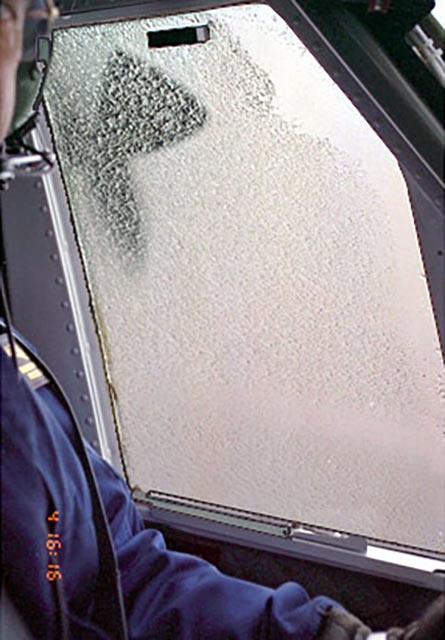
Ice on side window of Twin Otter
PIREPs Check the Weather
The standard format for a PIREP is:
- Nearest Station
- Report Type
- Location
- Time
- Altitude
- Aircraft type
- Sky conditions
- Weather
- Temperature
- Wind speed and direction
- Turbulence
- Ice type and severity
- Remarks
However, few PIREPs actually list all of this information. The accuracy of much of this information depends on the skills of the observers and the clarity of their reports. To properly interpret PIREPs you must keep these limitations in mind.
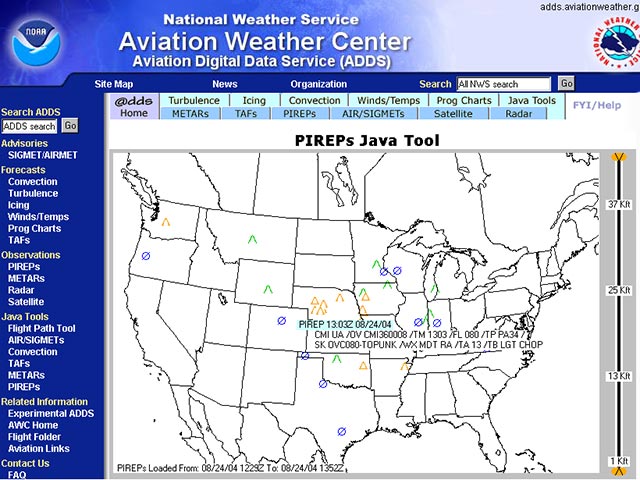
Interactive PIREP tool from ADDS
Related Information
ASE UUA/OV ASE 090060-ASE 270010/TM
1235/FL140/TP MU2 /SK OVC UNKN-TOP 190/IC SEV 180-140
UUA/OV EUG 152020/TM 1515/FL090/TP BE99/TA
M10/IC MDT-SVR RIME/RM 25 KT LOSS IN
AIRSPEED OVR 3 MILES.
PIREPs Check the Weather
The locations, times, and altitudes given in PIREPs may pertain to the aircraft at the time of the report or to the weather phenomenon being reported. In many cases, the location and altitude of the aircraft at the time the report is made may differ substantially from the location and altitude of the icing. PIREPs are likely to be made after a significant event, when time and workload permit. The altitude and position of an icing encounter may be recalled from memory and therefore be biased toward the altitude and position observed by the pilot at the time the report was made. In other cases, a pilot may report only that icing was encountered during climb-out or descent from an airport, making it difficult to determine precisely where the icing layer is located.
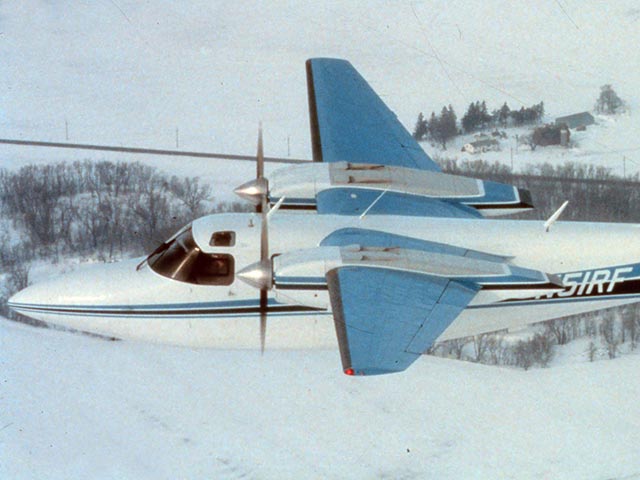
NOAA research aircraft
PIREPs Check the Weather
Ice Type and Severity
In PIREPs, ice is classified as rime, clear, or mixed. To standardize the reporting of the severity of icing encounters, the FAA has defined four levels of icing severity:
- Trace Icing
- Light Icing
- Moderate Icing
- Severe Icing
The current definitions are based on length of exposure, amount of accumulation, and the effect of the accumulation on the aircraft. These definitions are under review and may change. Refer to the Airmen's Information Manual (AIM) for the current definitions.
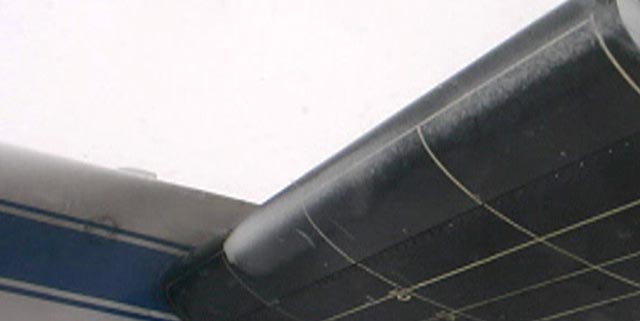
Trace Ice
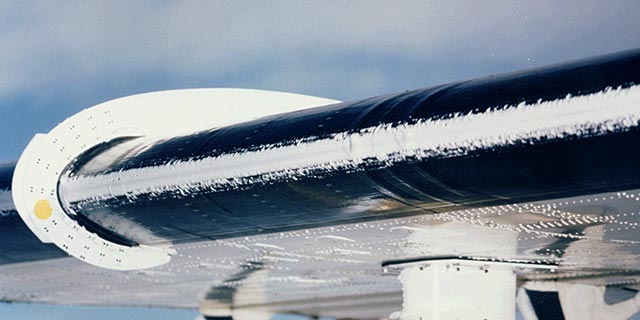
Light Rime Ice
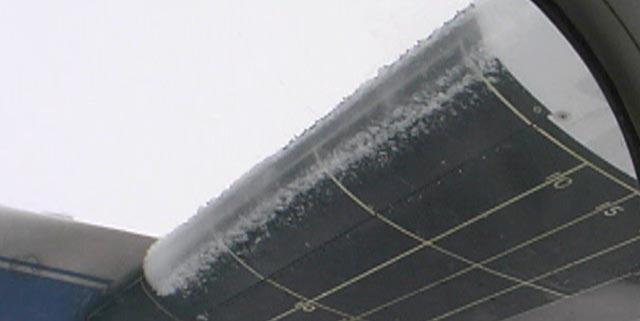
Moderate Mixed Ice
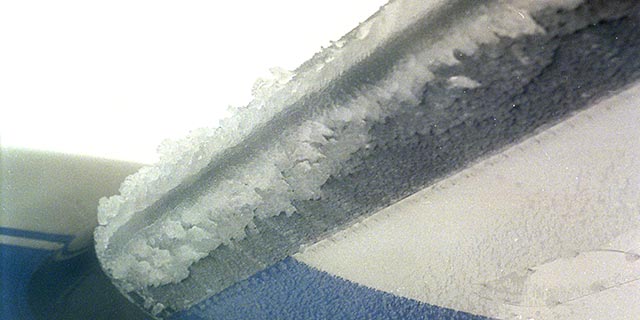
Severe Clear Ice
PIREPs Check the Weather
Trace icing: Ice becomes perceptible. Rate of accumulation is slightly greater than the rate of sublimation.
Light icing: The rate of accumulation (1/4-inch in 15-60 minutes) is such that the occasional use of ice protection systems is required to remove or prevent accumulation.
Moderate icing: The rate of accumulation (1/4-inch in 5-15 minutes) is such that frequent use of ice protection systems is necessary to remove or prevent ice. Unless actions are taken, substantial amounts of ice will build on the airfoil. At this intensity, the rate of accumulation may present a problem even with short encounters.
Severe icing: The rate of accumulation (1/4-inch in less than 5 minutes) is so fast that ice protection systems fail to remove the accumulation of ice. Severe icing is usually a product of a clear or mixed icing encounter.
Judgements of ice type and severity are somewhat subjective and depend on the pilot making the report.
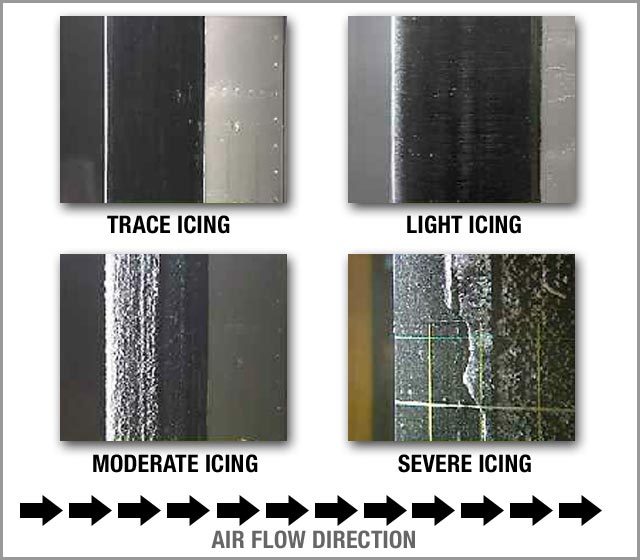
Four Types of Ice Accretion (Images are top view)
PIREPs Check the Weather
The severity of an icing encounter depends in part on the aircraft.
Slower aircraft will take longer to transit through icing areas and are therefore exposed to the potential hazard for a longer period of time. For example, because a piston single climbs at a much slower rate than a twin-engine turboprop, the piston single will spend more time climbing through an icing layer and probably accrete more ice than the turboprop. The pilot of the piston single might experience "moderate" icing while the pilot of the turboprop experiences only "light" icing. A regional jet climbing through the same area at the same time might accumulate very little ice.


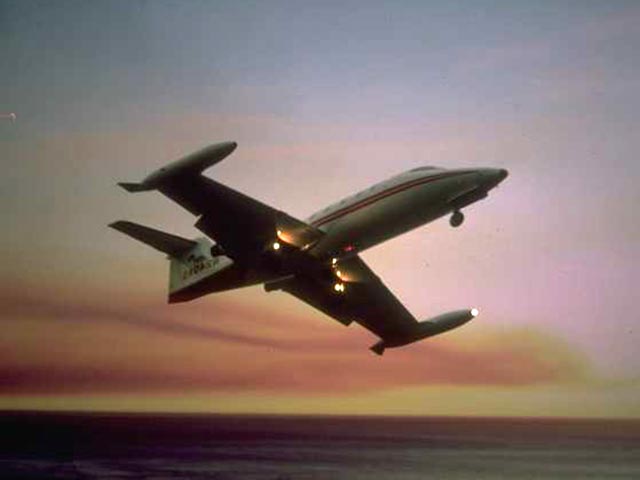
Various aircraft in flight
PIREPs Check the Weather
When icing conditions are present, recent pilot reports of "no icing" can be as useful as reports of icing. Knowing where ice has not been encountered will help you as you build a strategy to minimize your icing exposure. However, the absence of a PIREP along your route is not an indication of an ice-free environment. Unlike routine weather reports and forecasts, PIREPs are not made systematically.
There are many reasons why there may be no PIREPs along your route of flight. No aircraft may have traversed that route. Pilots may have encountered ice along that route but they may have failed to make a PIREP or they may have made a PIREP that has not yet entered the system. Furthermore, icing conditions are transitory. Therefore, it is possible for only some of the aircraft flying along a route to encounter ice.

Side window view from aircraft in flight
Related Information
MONROE, MICHIGAN
JANUARY 9, 1997
EMB-120
The aircraft was being vectored for an ILS approach to Detroit (DTW). The pilots slowed the aircraft to 150 knots while the aircraft leveled at 4,000 feet. While turning to the assigned heading the aircraft experienced an uncommanded roll and the autopilot disconnected.
Less than two seconds after the autopilot disconnected the flight data recorder indicated roll attitude increased from about 45 degrees left bank to about 140 degrees left bank and the pitch attitude decreased from nearly 2 degrees nose up to about 17 degrees nose down.
The control wheel position moved from about 18 degrees right to 19 degrees left. The aircraft struck the ground in a steep nose-down attitude about 19 nautical miles southwest of the airport.
Evidence indicates that the aircraft was picking up ice at a significant rate for less than a minute and the total accumulation was between 1/4 to 1/2 inch of ice.
MONROE, MICHIGAN
JANUARY 9, 1997
EMB-120
Examine the following two PIREPs...
DTW UA/OV DTW 230025/TM 1610/FL050/TP DC3/IC MDT MIXED
(Local time - 16:10 UTC - 21:10)
DTW UA/OV DTW 240021/TM 1738/FL040/TP
C310/TA-10/TB LGT OCNL MDT CHOP/IC NEG/RM BTWN LYRS
(Local time - 17:38 UTC - 22:38)
These two PIREPs illustrate the transitory nature of icing.
At approximately 20:54 only a few miles away over Monroe, Michigan an EMB-120RT crashed during a rapid descent after an uncommanded roll. It is likely that the aircraft accumulated clear-mixed ice on the leading edge deicing boots, possibly with an ice ridge forming on the upper surface leading edge, as the airplane descended from 7,000 feet to 4,000 feet in icing conditions.
MONROE, MICHIGAN
JANUARY 9, 1997
EMB-120
The NTSB developed a questionnaire to gather more information about the weather conditions at the time of the Monroe, Michigan accident. Pilots operating in the area at the time of the accident reported the following:
- About 10 minutes ahead of flight 3272, a pilot reported light rime icing while on approach.
- About 5 minutes ahead of flight 3272, a pilot observed no icing on the approach.
- About 1 minute ahead of flight 3272, a pilot reported moderate rime icing.
- About 2 minutes behind flight 3272 a pilot reported moderate-to-severe icing.
PIREPs Check the Weather
Making a PIREP is the most direct way that you can help another pilot. Pilots on the ground and in the air use PIREPs. Forecasters use PIREPs in developing and modifying forecasts. Pilots flying IFR are required to file a PIREP whenever they encounter unforecast conditions that could significantly affect the flight.
PIREPs can be made to ATC. However, the most effective way to make a PIREP is directly with a Flight Service Station. If you want to file a PIREP with ATC, make sure that your PIREP enters the system, by explicitly stating "I would like to make a Pilot Report"
You should not feel deterred from making a PIREP because you did not record all of the information that could be reported or because you do not recall the standard format. PIREPs in any form are always welcome.
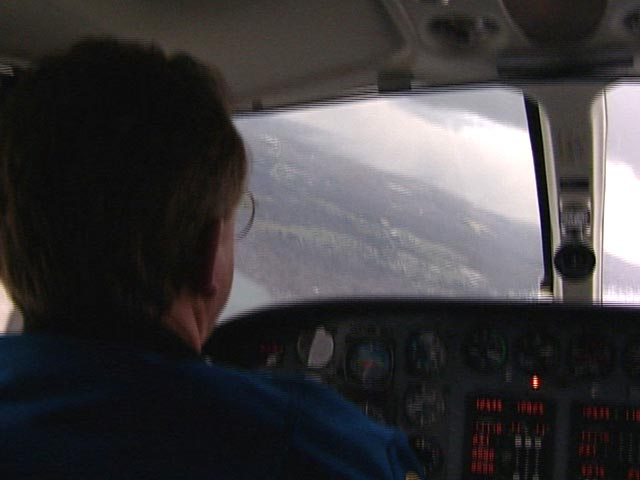

Making PIREPs is the most direct way to help other pilots